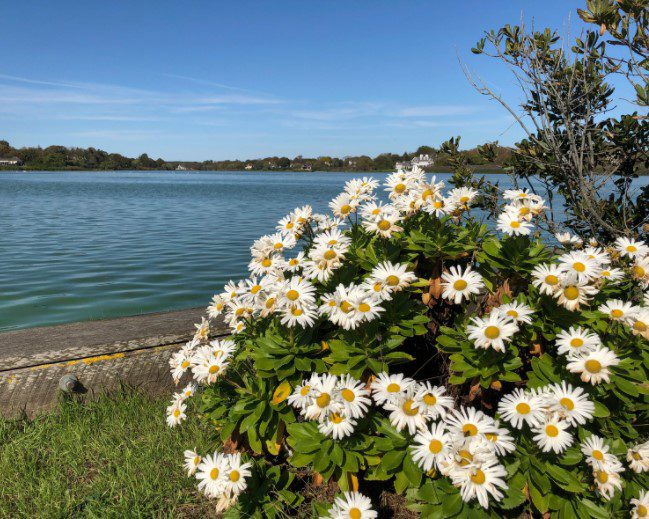Montauk Daisy
Montauk daisies (Nipponanthemum nipponicum) are in full bloom in my garden as late as Christmas.
The flowers of the Montauk daisy have white petals with bright yellow centers and look much like the blooms of the summer-flowering Shasta daisy.
However, the foliage of Montauk daisies is a bit more succulent and leathery and can reach a good 3 feet in height. The flowers are frost-tolerant and can withstand freezing temperatures.
The only real maintenance this plant needs is a heavy pinching in early summer to keep its growth compact and delay the flowering (much like a chrysanthemum).
In early June, use a pair of sharp pruners or fingers to remove the top third to half of each stem. Plant Montauk daisies in full sun, where they’ll thrive even in drought conditions.
These perennial shrubs will die to the ground in winter and then bloom the following fall. They produce tough, toothed, hardy leaves in spring.
In autumn, they become covered with yellow-centered, white daisy-like flowers.
Montauk daisies can tolerate moderate salt, which is a plus for people who live near the coast.
Montauk Daisy Care is Easy
They need well-draining soil and can be found naturally along the east coast of the United States. They require full sunlight.
They will not tolerate damp soil. Too much shade can cause fungal diseases and rots.
Montauk daisies can grow to 3 feet (91cm) tall if left untended. They can grow tall and wide and may flop over if left untended.
This makes them compact and keeps them tighter. It also forces them to bloom in the fall and late summer, when the rest is dying.
Montauk Daisy History
Asteraceae, the Aster Family
This robust, shrubby, perennial daisy is endemic to the maritime rocky slopes and shores of Honshu Island, Japan (Iwatsuki et al., 1995). In Northern America, it has been reported as adventive in coastal New Jersey and New York (Strother 2006, USDA Plants 2009).
The first published report of naturalized Nippon daisy from the Torrey Range was based on a 1988 collection from Orient Beach State Park, Suffolk County, New York (Lamont and Stalter 1991).
Subsequently, Steven Glenn found it in 2004 naturalized along a coastal area in Fairfield County, Connecticut, and again in 2005 and 2006 at several localities on the South Fork of Long Island, New York.
In 2008, naturalized N. nipponicum was located on the north shore of Long Island at Caumsett State Park, Suffolk County, by Andrew Greller. It appears that N. nipponicum has become established in our coastal zones, but at present, it does not exhibit characteristics of an invasive species.
Another common name for this species is Montauk daisy, which intimates that this species might have been established on eastern Long Island longer than the botanical community has realized.
Concerning the alleged origin of Montauk daisy, one garden website notes, “Curiously, the tag that came with the plant states that it is native to the area around the Montauk Lighthouse in the state of New York.
” Likewise, another garden website notes, “This all took place in the 1950’s when the South Fork villages were not as well developed. The area was gentrified, and nurseries and landscape professionals arrived.
They decided that the ubiquitous Nippon Daisy was a key component of any local landscape design. However, the name was wrong. They changed the name to Montauk Daisy.”
Many eastern Long Island landscapers utilize N. nipponicum for planting in coastal and other dry situations, and this is probably how the species was introduced into the Torrey Range.























